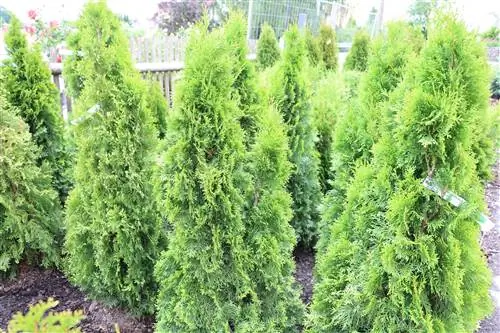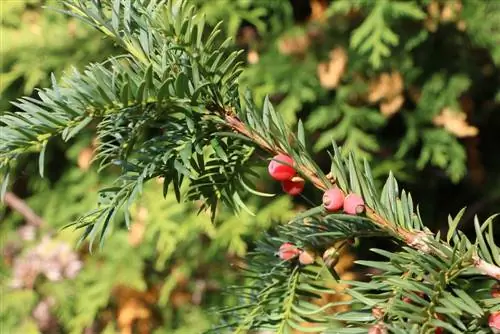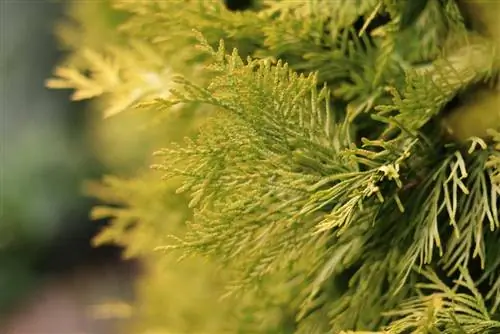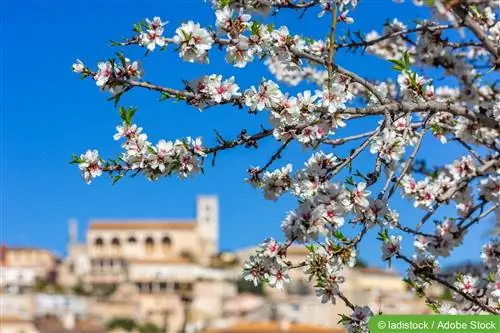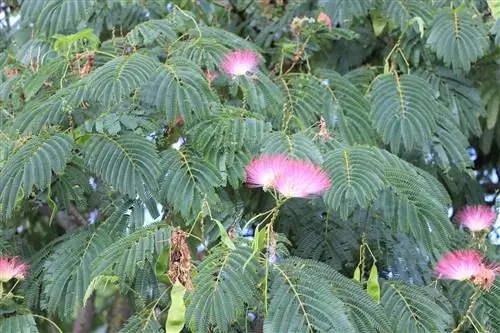- Author admin [email protected].
- Public 2023-12-17 03:39.
- Last modified 2025-06-01 06:48.
The 'Emerald' tree of life can grow up to seven meters high and almost two meters wide. The annual growth is only 10 cm in height and 5 cm in width, but it grows almost by itself, dense with a slender, cone-shaped silhouette. If you provide optimal conditions when planting, you will create a good basis for a functional hedge or a fascinating solitary plant. It is evergreen and only turns brown-green at the tips in winter.
Location
The 'Smaragd' tree of life likes it bright. A sunny to partially shaded location is perfect. If in doubt, it is better to use full sun rather than full shade. Here it forms fewer needles, grows more loosely and does not offer optimal privacy. As a solitary plant, it loses its attractive, compact, characteristic shape in the shade.
Floor
The Thuja 'Smaragd' does not have great demands on the substrate. However, the soil should tend to be moist rather than too dry. The permeability of the soil is also important. The thuja roots within the first meter and most of the fine roots for nutrient absorption are only a maximum of 20 cm deep. However, if he finds loose soil, some strong roots can take root a little deeper. This then has a positive effect on the watering effort in dry times. Otherwise he tolerates:
- slightly alkaline, neutral and slightly acidic soils
- nutrient-rich and nutrient-poor soils
Tip:
If the needles turn dark brown over time, it may be that the soil is too acidic. First aid is a dose of carbonated lime. Later, soil improvement with compost additions.
Shopping
In tree nurseries and garden centers, Thuja 'Smaragd' is usually available in containers or bales, in sizes of 40 - 130 cm. If you want to create a hedge, calculate 3 plants per meter. There are different growth rates among thujas. While the 'Brabant' tree of life grows 30 cm tall every year, the 'Smaragd' tree of life only grows 10 cm. So it may take a while at the beginning until a considerable height is reached. Over the years, this growth characteristic has advantages again because it requires little pruning.
Tip:
When purchasing larger lots of thuja in containers, you should make sure that they are well rooted in the container. Some garden centers simply put baled goods in pots and offer them as container goods. When you take it out, the soil almost completely crumbles away from the roots.
Plants
The 'Smaragd' tree of life is suitable as a hedge plant as well as a solitary or container plant. A few plants can also be attractive as a windbreak and a soft green background for colorful side plants. Spring is the best time for planting, although containers can be used almost all year round. Good soil preparation gives the otherwise undemanding thuja the best starting conditions. The soil should be generously loosened downwards and to the sides. If the floor is firm, it is definitely worth loosening up the sole thoroughly towards the bottom. To improve water drainage, you can mix this soil with sand.
The planting holes are dug twice as deep and twice as wide as the root ball. The excavation is enriched with plenty of compost. For hedge planting, you should expect a plant spacing of 40 - 50 cm between the plants. Don't forget to get information in advance about the distance between the hedge and neighboring properties. The regulations vary in the individual federal states. The root area of the plant should be well watered before planting. Bale goods are immersed in water until no more bubbles appear.
Tamp down the plant carefully and water thoroughly. This works best when the ground level around the trunk is slightly lower. The most common reason why young thujas die is not the quality of the plant, but rather drought. After planting, water thoroughly regularly and only ease off a little when it starts to grow taller.
Tip:
A few Thuja 'Smaragd' plants provide a beautiful background to really make the colors of the plants in front of them shine. Roses, peonies or lilies look particularly beautiful in front of it. Flowering shrubs can also break up the monotonous green of a hedge. For example hydrangeas, Pfaffenhütchen or crabapples.
Cutting
Due to its slow, straight and compact growth, the 'Smaragd' tree of life does not necessarily need to be cut. However, you can increase the growth density with regular pruning. Beautiful effects can also be created with an annual topiary. So according to the motto everything can, nothing has to. Cutting takes place from April to summer. However, due to bird protection, in most federal states no radical cuts can be made between March and September. Shape and care cuts are not affected by this. As a hedge or as a shorter protective wall, cutting can be done once to three times a year.
One cut per year
The best date is shortly after June 24th, the “Cut to Johanni”. Now the new shoots have developed well. If you shorten it by a third, it stimulates branching. The hedge or the solitary plant grows denser and bushier.
Three cuts per year
This effect can be increased if you prune three times a year:
- first cut in early spring
- second cut at the end of June
- third cut at the end of August
There will be no more editing after that. The new shoots should be able to mature in peace in September. Thuja 'Smaragd' responds to radical pruning with bald spots that require a long time to regenerate. To shorten the height of a tree or hedge significantly, you also need a chainsaw; a hedge trimmer is too weak for the strong inner branches.
Conclusion of the editors
If you enjoy designing your garden, you will find the 'Emerald' tree of life an interesting addition. As a solitary plant in the garden or in a container, it can enrich boring or restless garden corners with its conical growth. It is useful for use as a hedge plant. Without too much effort, you can grow a really dense hedge in a few years. If a particularly high level of privacy protection is required, this Thuja variety is particularly suitable, even if it takes some time until it grows three or more meters high. Ecologically, the 'Emerald' tree of life is also better than its reputation. Birds nest in it and like to use this privacy screen, which also exists in winter, as protection from birds of prey.
What you should know about the 'Emerald' tree of life in brief
Planting time
- The 'Smaragd' tree of life can be planted in spring or autumn. The best time is right after the frost period: March to April.
- Then the plant still has enough time to form roots with which it can absorb the amount of water it needs in the summer months.
- In autumn, September is the ideal month for planting, as the tree of life can take root well before the first frost.
- However, October and November are also still possible.
Plants
- The planting hole is dug deep two to three times the width of the root ball.
- After planting the plant, it is filled with compost prepared soil.
- The soil must under no circumstances dry out, especially in the first year after planting.
- A several centimeter thick cover of bark mulch protects against excessive evaporation, especially in summer.
- The plants like a sunny location, but partial shade is also well tolerated.
- The 'Smaragd' variety is undemanding and can cope with any normal soil as long as it does not dry out for a long time.
- Waterlogging is just as difficult as drought.
- Ideally, the soil is slightly acidic to alkaline; lime is well tolerated by the variety.
Cutting
- The western arborvitae in particular is popular for its great pruning tolerance.
- It can be cut back to almost any height and width.
- The only thing the plants don't like is being cut back into the old wood; they won't sprout new ones there.
- You should refrain from pruning in bright sunshine, as the freshly cut shoots can quickly burn.
- Pruning is not necessary for this variety, it only serves to regulate the height and width.
- 'Emerald' is rarely used as a solitaire. It reaches a maximum height of 5 to 6 meters without cutting and grows very slowly.
- This variety only reaches the most desired hedge height of 2 meters after approx. 15 years.
- If you want to cut the plants, May/June is the best time for it.
- As long as there are still small leaves on the remaining shoots, they will sprout again.
- If you cut it directly on the trunk, the area usually remains bare and will only be covered by shoots from neighboring plants if you are lucky.
- A small correction cut is possible again in August if necessary.
- If a very old hedge has become too high, there is usually not much that can be done. If you cut back into old wood, emerald will no longer sprout again!
- However, if the variety is cut at a height of approx. 2 meters, this is not so bad because you cannot see the bare spots at height.

